The 22-year-old Senegalese forward Amadou Sagna (173cm/5’8”, 63kg/138lbs) joined National 1’s Stade Briochin on a season-long loan from one of Belgium’s biggest teams, Club Brugge, last summer. While the versatile attacker, who’s primarily a centre-forward but has also regularly featured on both the right and left-wing for his team in 2021/22, has only scored three league goals this term, it wouldn’t be wise to overlook his overall performances for Stade Briochin throughout his loan spell, which have been rather promising.
As a result, Amadou Sagna is the seventh and final player to be profiled in our National 1 scout report series, here at Total Football Analysis, which has seen us provide in-depth analysis of the following: Florent Da Silva at Villefranche (on loan from Ligue 1 side Lyon), Godson Kyeremeh (on loan at Annecy (on loan from Ligue 2’s Caen), Sagna’s Stade Briochin teammate Ahmad Allée, Avranches’ PSG academy product Harold Voyer, Sète’s Walid Jarmouni (on loan from Ligue 2’s Sochaux) and SO Cholet’s Ryad Hachem.
This attacker’s parent club, where he’s been developing since 2019, has been home to players such as Inter’s Ivan Perišić and Borussia Dortmund’s Thomas Meunier in the past, among plenty of other notable names, with the highly-rated Charles De Ketelaere and Noa Lang among Blauw-Zwart’s current crop of budding talents. I’m not saying Sagna will reach the levels of Perišić or Meunier, nor is he secretly a talent at the level of De Ketelaere or Lang. However, the 22-year-old has been a bright spark for Stade Briochin this term, albeit while showing some notable weaknesses at the same time that could put some off him — perhaps making him a potential coup for clubs looking to use the National 1 / Belgian market in the transfer window.
Indeed, Sagna’s contributions have been recognised by his club despite the forward only bagging three league goals this term, as he is one of five nominees for the club’s ‘Player of the Year’ award (alongside Ahmad Allée, who we previously looked at in this scout report series), with the club describing him as their “defender on the front” in a tweet announcing that fact. I feel this is a fair moniker for the attacker but one that could also do the player an injustice, as he’s far more than just a pair of legs defensively, as we’ll go on to highlight in this tactical analysis and scout report piece that aims to provide in-depth analysis of Sagna and his role in Stade Briochin’s strategy and tactics this term.
Movement
We’ll kick this scout report off by looking at the forward’s off-the-ball movement. While Sagna has scored just three league goals in 2021/22, he’s done that from a far better xG of 6.11. This does average out to 0.3 xG per 90, which is, again, less impressive and ranks the forward just above average in terms of xG per 90 when compared with other National 1 forwards this season. However, the big picture here is that the attacker has significantly underperformed his xG this term and has actually been managing to get himself into promising offensive positions far more frequently than his actual goalscoring record would suggest.
Part of the reason for this is the player’s runs and off-the-ball movement to find space in high-value positions where his teammates can find him to get a shot off. We’ll analyse some of the key traits and attributes in his game that have helped him to achieve this so often this season in our first section of analysis.
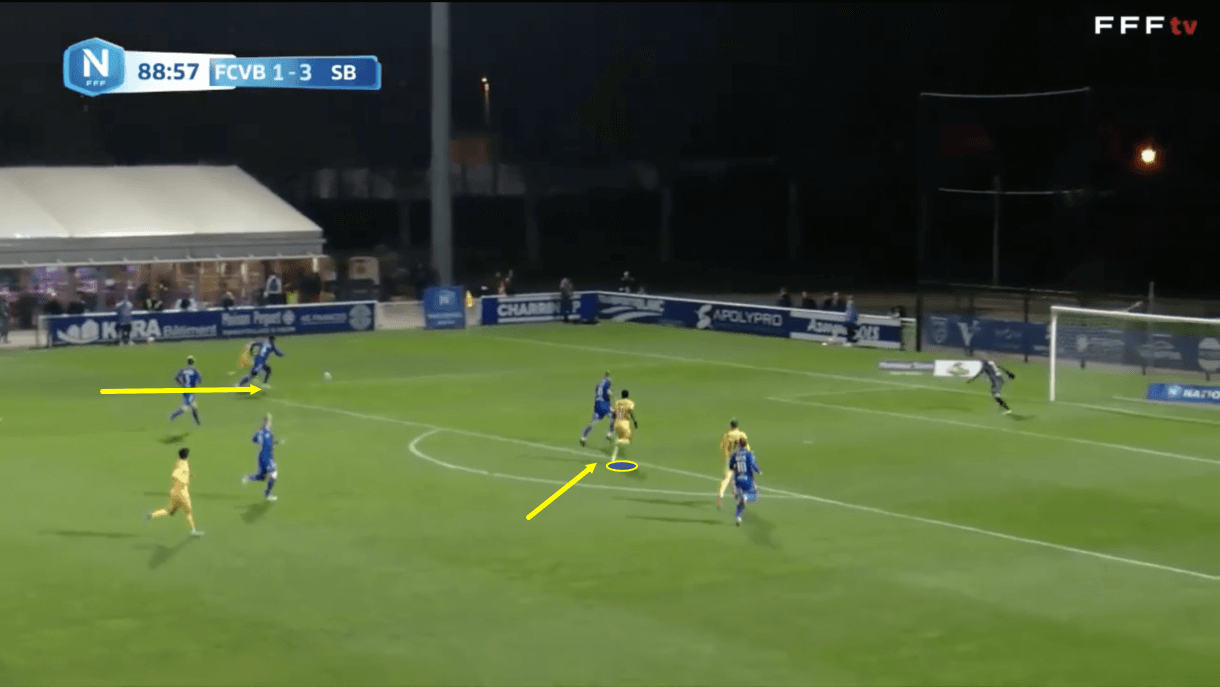
In figure 1, we see the attacker arriving into the box as his teammate on the left-wing gets past his man, the opposition’s right-back, to progress further up the wing into a better crossing position. As the wide player beats his man, Sagna is not in an ideal position to give him an option as he’s just behind an opposition centre-back who’s effectively controlling the 22-year-old at this point, blocking the passing lane into him.
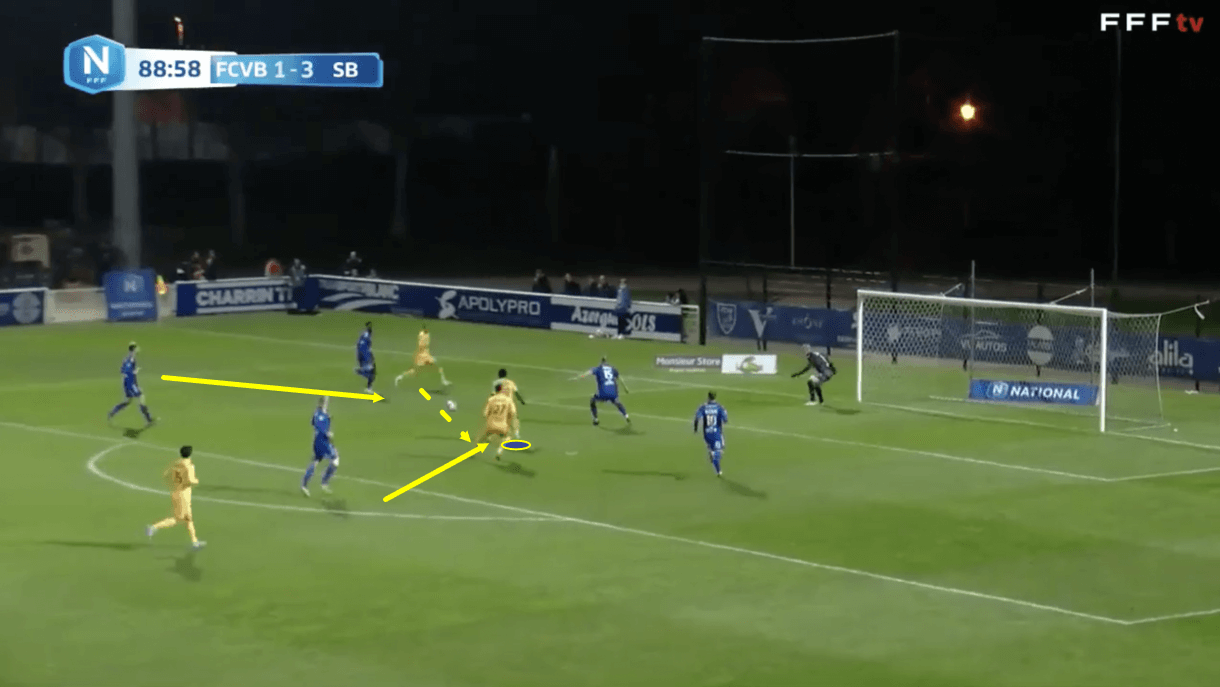
However, moving into figure 2, we see how Sagna proved to have been comfortable in this position just behind the centre-back at that moment, as the attacker pulled off a sharp movement towards the left-wing that caught the defender off-guard, helping the 22-year-old forward to get around the centre-back and into a better position where he can get onto the end of this low cutback cross.
Stade Briochin like to play low cutback crosses like this one a lot, while they don’t play very many high crosses, with Sagna having engaged in a relatively low number of aerial duels this term, which further highlights why this movement around the defender was necessary and valuable for the team. The attacker is capable of pulling off sharp movements like this one a lot and likes to use these to open up goalscoring possibilities for his side, as was the case here. This is an important element of the Club Brugge man’s game that has led to him generating plenty of goalscoring opportunities this term.
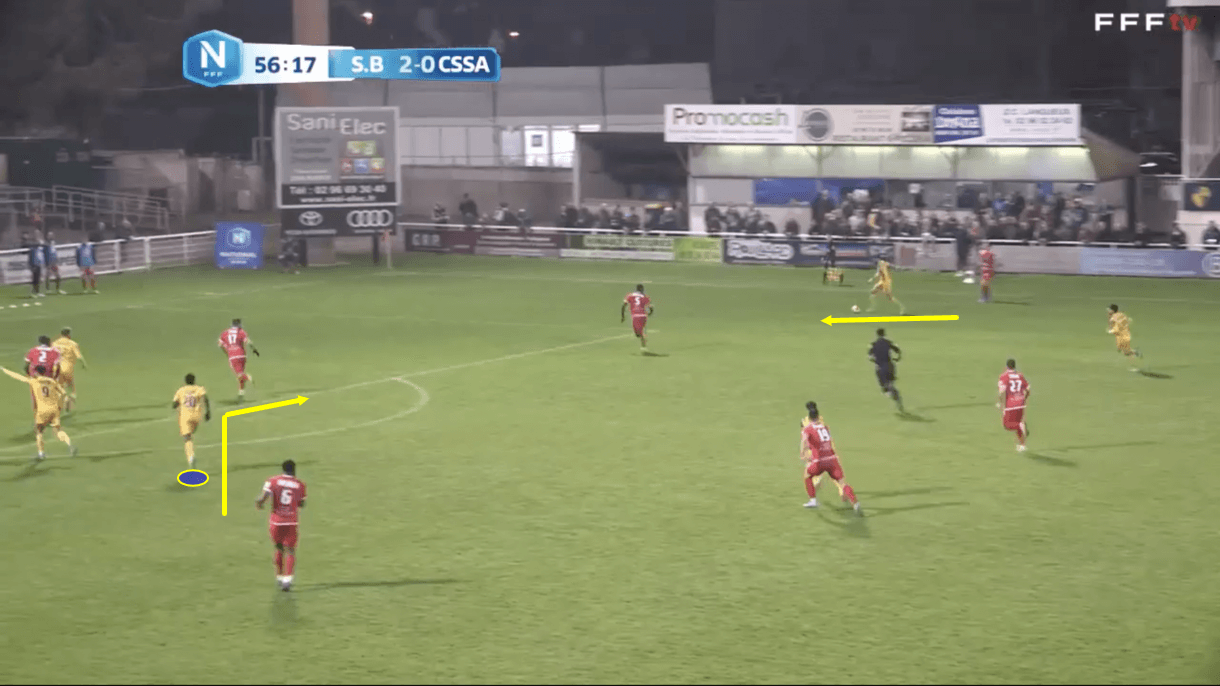
Figures 3-4 show another example of Sagna’s sharp movements to change direction and open up different possibilities for his side. In figure 3, we see Sagna, again, just about to arrive in the box. On this occasion, the ball is making its way down the right-wing with a wide Stade Briochin player, as opposed to the left-wing which we saw in the previous passage of play.
Before making it into the penalty area, Sagna opts to sharply pull towards the right-wing here, angling his body towards the winger making his way towards the box. As he does so, he manages to create some space between himself and the pack of defenders dropping deeper into the box for a moment or two, allowing himself to receive the ball to feet and turn to take it just inside the box.
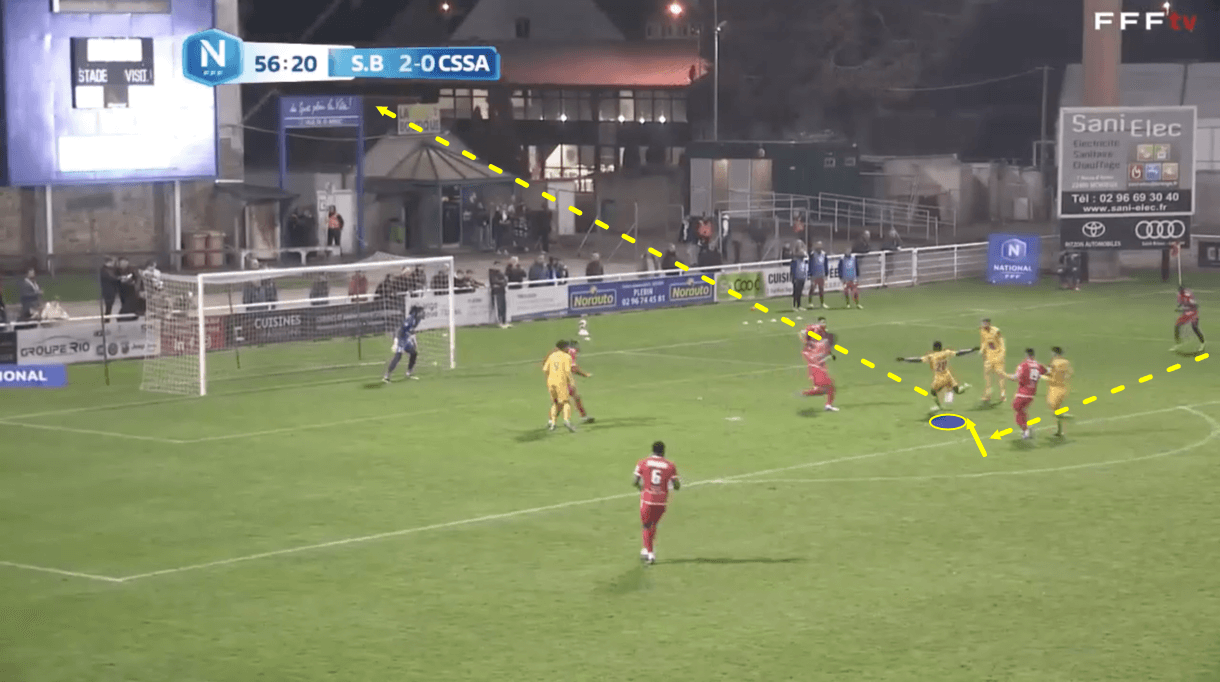
As we progress into figure 4, we see that this movement and the player’s subsequent touches were more than good enough to create a shooting opportunity for the 22-year-old. However, the resulting shot was inaccurate and ultimately flew high and wide. This highlights a major issue in Sagna’s game as a forward: he does lack composure in front of goal. Perhaps this goes some way to explaining his xG underperformance, though luck and other factors will certainly be at play too and maybe his composure isn’t bad enough that it explains the entire xG underperformance, given how significant the gap is between Sagna’s xG and goals scored. However, it may explain some of it.
Sagna often snatches at chances, rushing into shots and ultimately wasting the opportunities rather than cherishing them and entering them with the necessary assuredness and composure to convert the chance into a goal. Even looking at the player’s body shape in figure 4 makes for difficult watching; he’s rushing into the shot while leaning back and angling himself to send the ball too high, which is exactly what happens. This is likely more of a mental issue than anything else, I’m not suggesting that he’s unaware of what’s wrong with this shooting technique, but it’s an area in which the attacker should put a lot of focus if he’s to reach his potential as a centre-forward.
Similarly, at times, Sagna’s shot selection is poor, with the attacker opting to take on low-value shots from very unlikely positions too often — this is another area in which the striker should look to hone his game.
Pace
Moving on into the next section of this scout report, we’re going to focus on one of Sagna’s greatest physical traits — his pace. The forward is rapid and this adds another dimension to his game which helps him to enter high-value goalscoring positions with great regularity. The off-the-ball movement discussed in the previous section can be useful in any situation where the attacker needs to find space to make himself more available to a teammate, regardless of whether his team is driving forward on the counter or looking to break into a well-organised low-block where space between defenders will be minimal. However, in this section of analysis, we’ll focus on how Sagna’s pace helps him to threaten a high line. The more space you give this man to run into, the more you put yourself at risk.
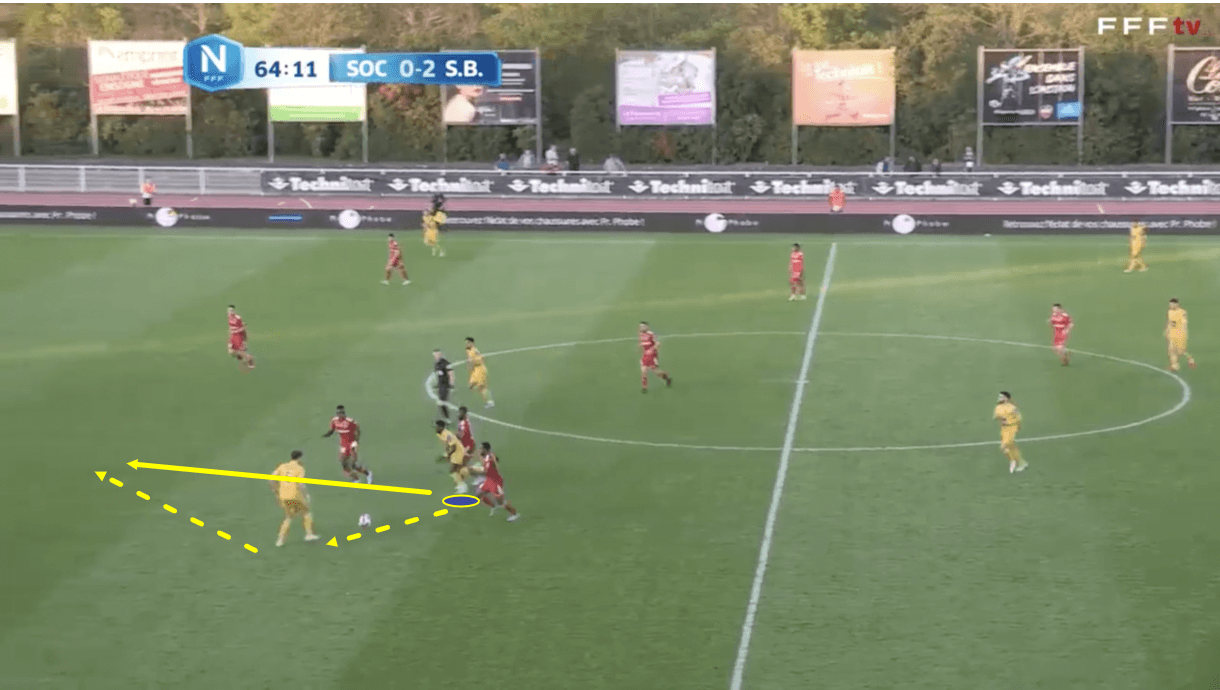
Figueres 5-7 will look at one example of Sagna’s pace and how it helped Stade Briochin to break past their opponents’ high defensive line in a recent National 1 clash. Just before this run, we saw Sagna attract players towards him via a run on the ball before releasing to a teammate positioned slightly further to the left, which we see in figure 5. After releasing the ball to his teammate, Sagna continues to accelerate, bursting forward, beyond the defensive line in search of a return pass to get through with space to stride away into.
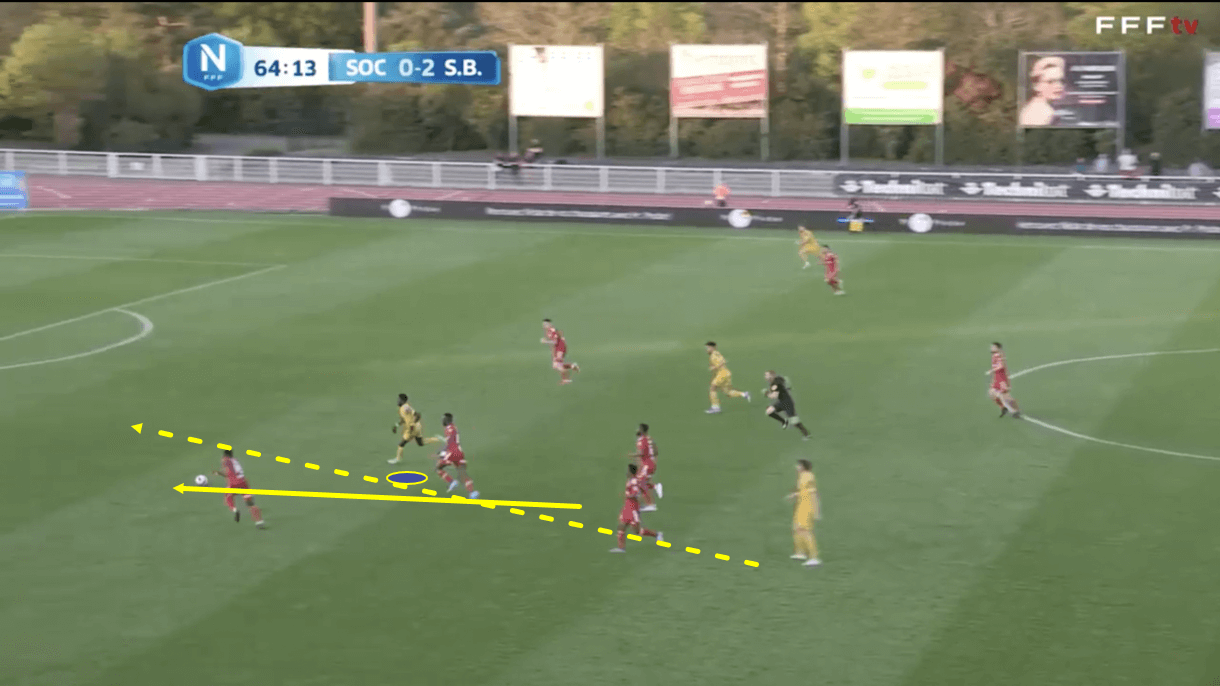
The return pass gives Sagna a little bit of work to do, as it’s played a little bit closer to a defensive player. However, what I like the most about this passage of play is how it highlights the actual level of pace that Sagna possesses. Despite the pass being played a little closer to the defensive player, Sagna was able to storm ahead and get onto the ball first, taking a heavy touch to drive forward to create a 1v1 with the goalkeeper.
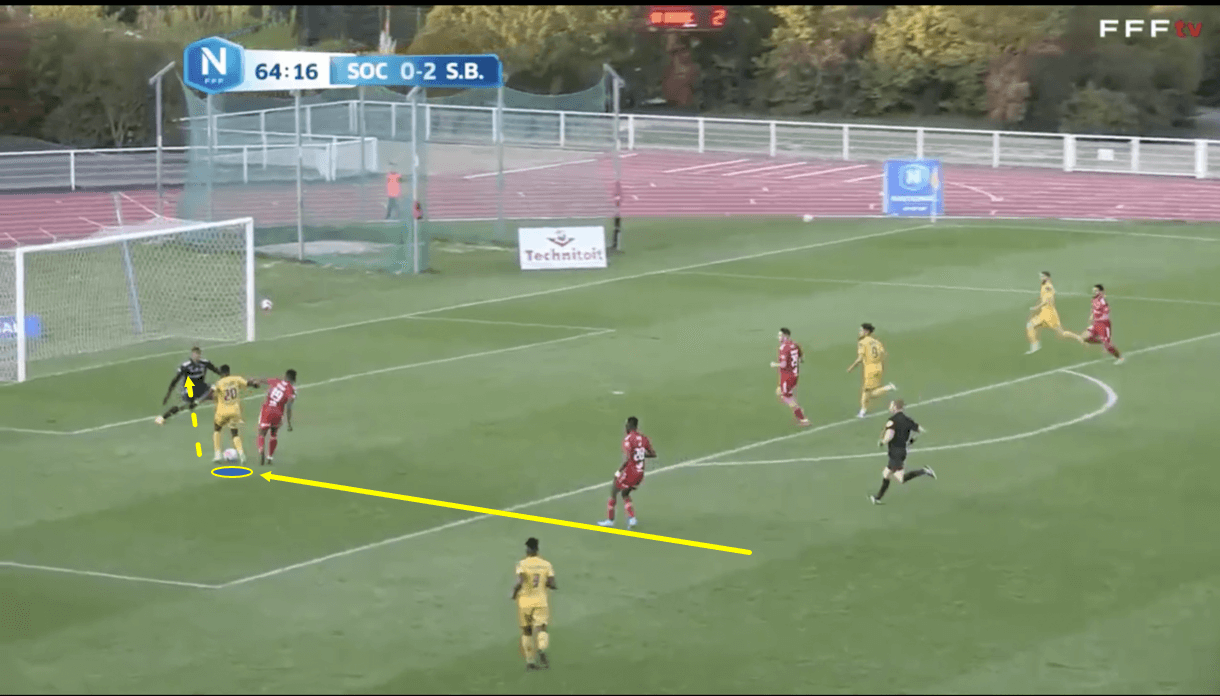
The defender tracking Sagna did his best to put the attacker off, as did the goalkeeper who charged out from his goal to reduce the forward’s shooting angle. As a result, we end up seeing Sagna attempt a chipped shot that ends up being saved by the ‘keeper. Again, perhaps with better composure, Sagna could’ve put his team three goals to the good here, or perhaps that’s harsh and more credit should be given to the defensive players; in my view, it’s probably a combination of both but on a more positive note, we see from this passage of play how Sagna’s pace and intelligent timing of runs help him to create excellent goalscoring opportunities for his side and present a big threat when playing against a team that leaves space to attack behind their defensive line.
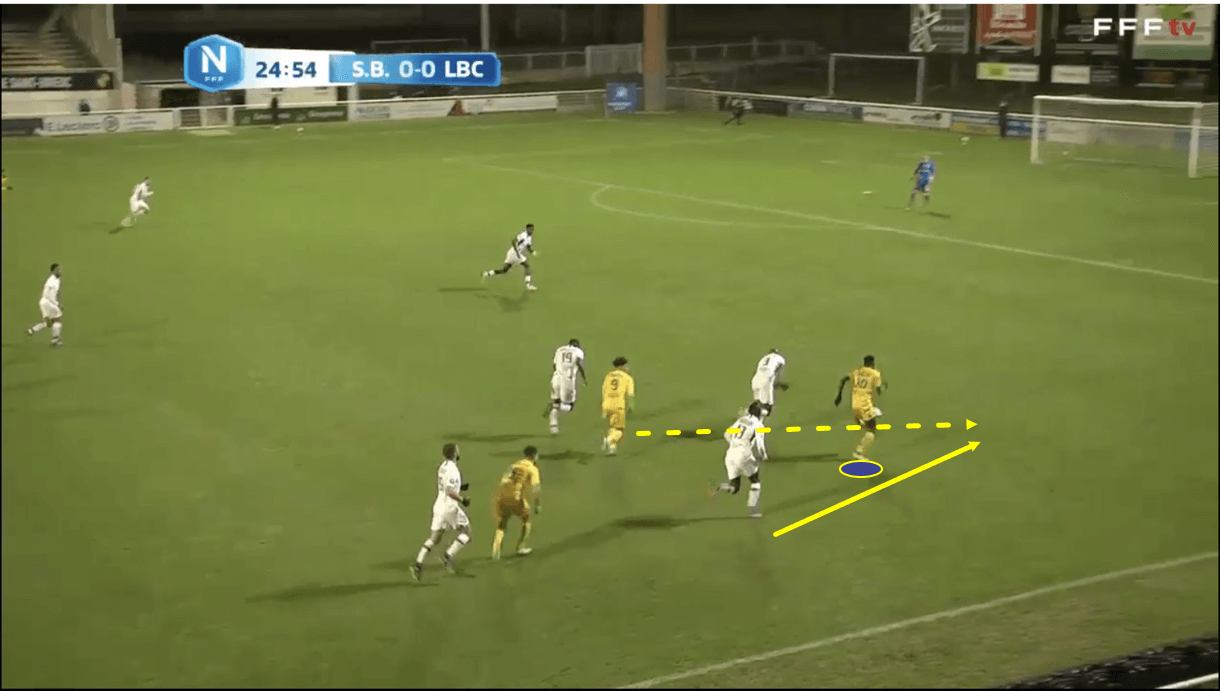
Of course, it’s not just when playing centrally when this pace comes in handy for Sagna — this is also a very useful aspect of the player’s game when on the wings, as figures 8-10 will show. Firstly, in figure 8, we see the attacker bursting forward on the outside, with his teammate having spotted the run and played a through pass into the 22-year-old’s path. The pass is played into a good area with good levels of power, allowing Sagna to continue accelerating while charging towards the ball.
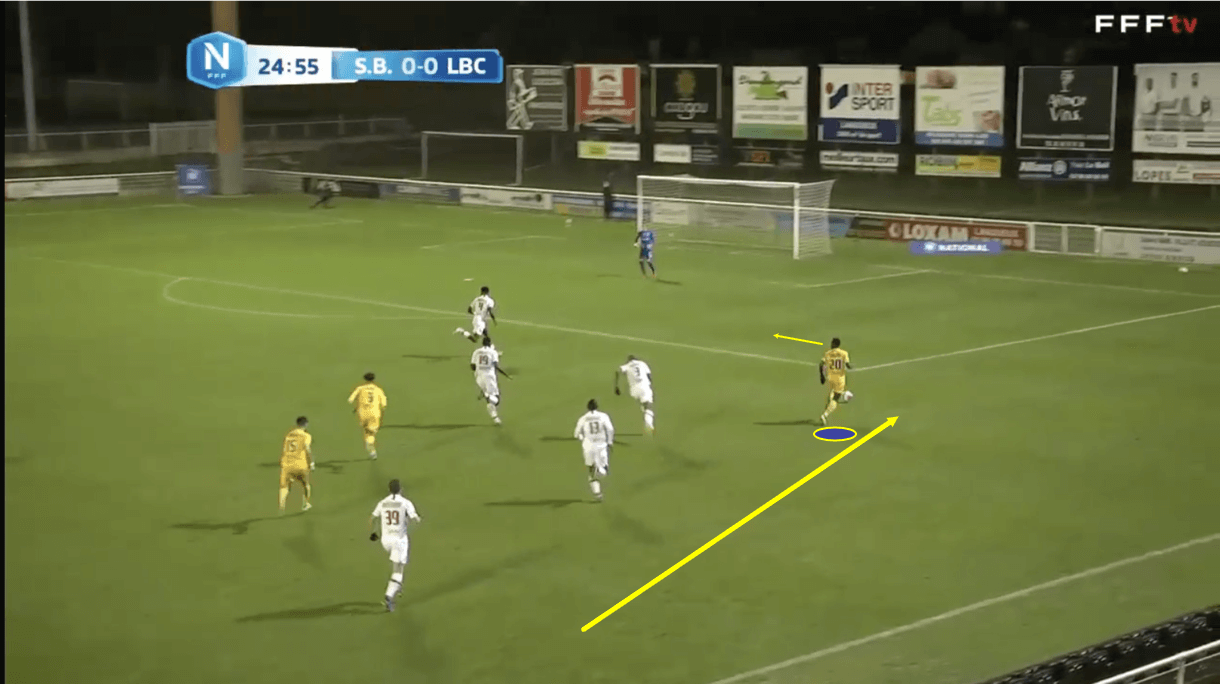
Again, with space to drive into, Sagna was able to take a heavy touch into the space ahead of him to pull away from the chasing pack, again highlighting his seriously impressive pace. As he approaches the penalty box here, he takes the time, in between touches, to get his head up and scan for movement into the box to consider his next move and assess whether he should look to make a cross or not here.
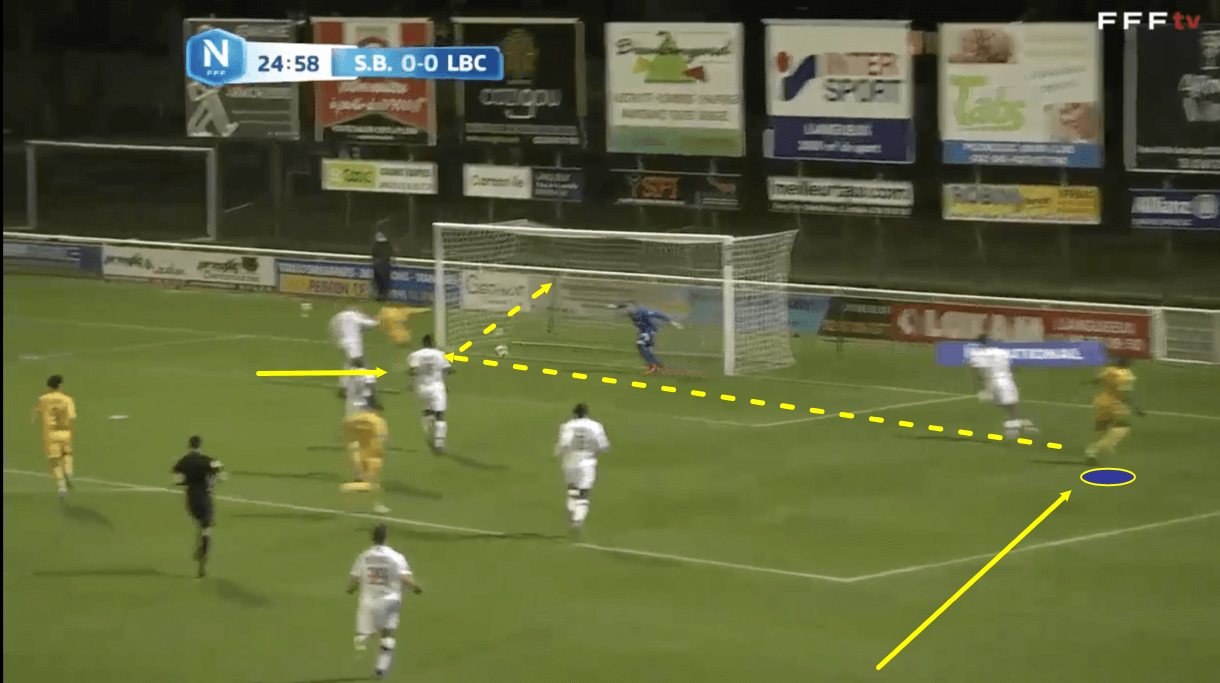
As he drove into the box, Sagna began to slow down a little bit to take the ball into more sensitive areas and allow his teammates to catch up, including this runner we see in figure 10 who ended up connecting with the 22-year-old’s low cross to the back post that flew across the face of goal with pace and power, giving the ‘keeper no chance.
This passage of play shows how Sagna can be utilised on the wings versus a high line, which Stade Briochin have switched to in the second half of this season, having utilised the forward more in the centre previously. Sagna has decent crossing in this team that likes to focus on low crosses, especially cutbacks, and has been a good creative force for his side when deployed on the wing this season, with his four league assists all coming when starting on the flanks. The attacker has generated 3.96 xA this term too, which ranks highly in this particular area among National 1 forwards. Perhaps the forward’s future lies on the wing, though I feel Sagna is still good centrally, as is evident from his movement as analysed in the first section of analysis in this piece. Ultimately, the forward is a good, versatile option to have in the side and if used as a squad player, could be very valuable in providing cover for several positions, which could result in the pacey attacker enjoying a lot of game time.
Dribbling
Sagna is a fairly impressive dribbler, as his relatively high (when compared with National 1’s other forwards) 5.98 dribbles per 90 and 54.55% dribble success rate this term, suggest. The attacker has also made a very high 3.66 progressive runs per 90 this season — which stands out as being among the best when compared with other National 1 attackers.
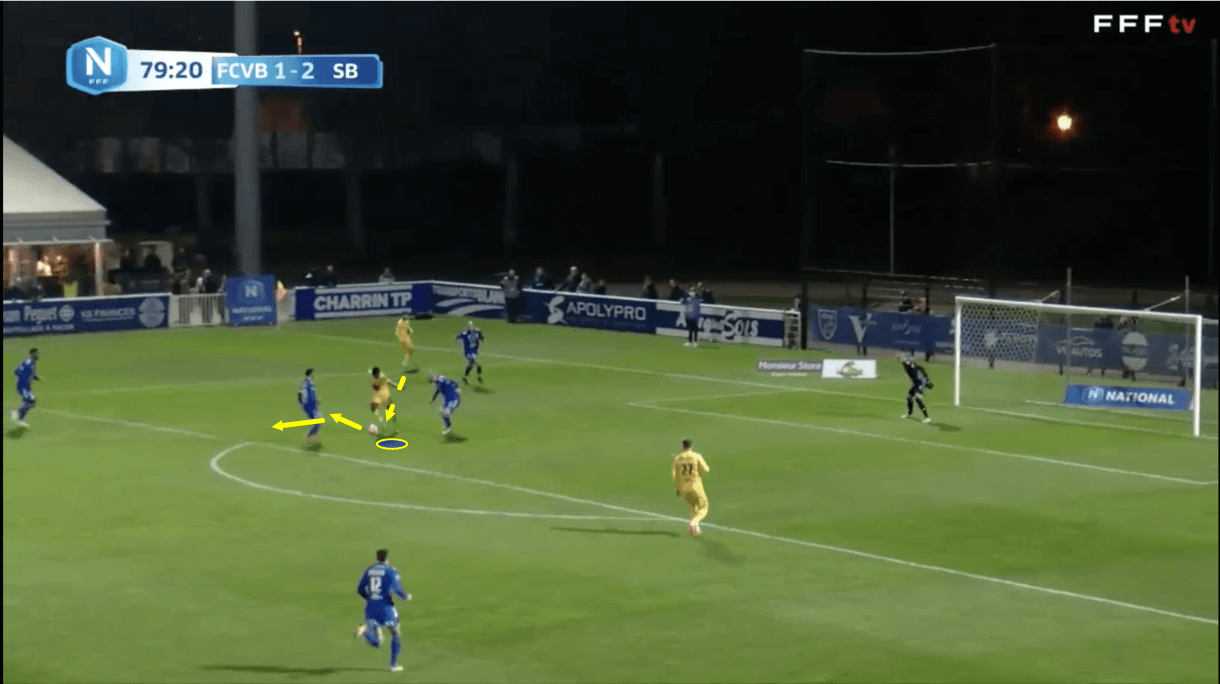
The forward has quick feet and impressive ability to evade challenges which we see, for example, in figures 11-12. Here in figure 11, we see the forward after having just received the ball to feet inside the penalty area. The ball was played slightly behind Sagna, forcing him to turn around after it was cut back into the box and play with his back to goal. At this point, we see that the forward attracted plenty of opposition pressure onto him, which created a possibility to be dispossessed.
However, thanks to his quick feet, quick thinking and decent levels of agility, he was able to evade the onrushing defender and get around them, into some space where they could continue the attack, which we see as we move on into figure 12.
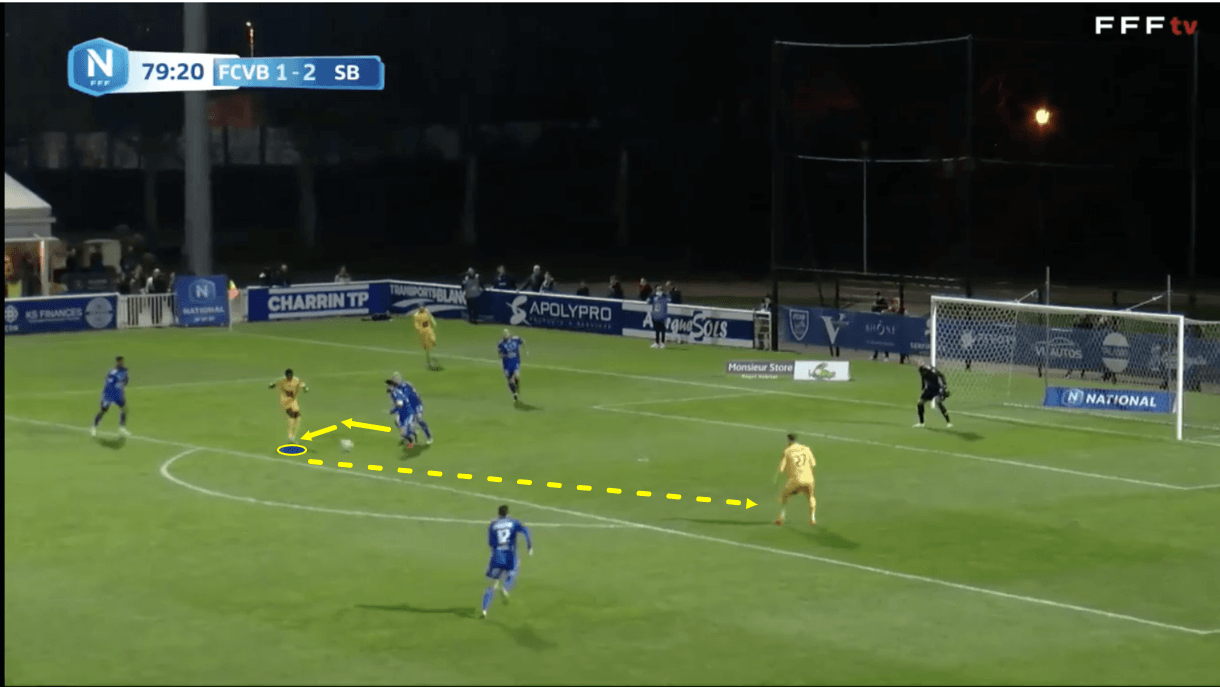
After getting around the challenge, Sagna enjoyed a little bit more space and created an opportunity for himself to send the ball across the box to a free man on the opposite side of the penalty area. The teammate enjoyed so much space partly thanks to Sagna’s ‘gravity’ (ability to draw defenders towards him) and ability to get around these players thanks to his dribbling quality.
This is just one example of Sagna’s dribbling ability, he’s great in relatively tight spaces, like we see here, or in bigger spaces where he has room to accelerate away and punish a team leaving too much space for him to attack. Again, this is a trait that can be useful centrally or on the wings — with his fairly high number of appearances on the wings in recent weeks giving him plenty of opportunities to exercise his dribbling ability, but any tactical setup that allows him to receive the ball to feet and either hold up the play, get out of a tight space and find a teammate in more space as a result or get the ball and drive at defenders, which he’s quite comfortable doing, is good for Sagna, regardless of position.
Hold-up play
Speaking of hold-up play, this is another related area in Sagna’s game where he thrives. As well as being pacey, Sagna’s physicality extends into the area of strength too. Despite being 173cm — not shockingly short but not very big either — the player is well-built and is well able to use his strength to back into opposition players, hold off defenders and protect the ball while either creating an opportunity for himself to get around the defenders or play the ball off to a teammate who’s either got upfield in support or found some more space as a result of Sagna taking advantage of his gravity.
The player doesn’t link up with deeper players a tonne but can perform well when needed to do so; though at times his touch or the pace at which he moves towards the ball can let him down, that’s not very common and in general, when playing with his back to goal and receiving the ball to feet, Sagna’s levels of control are good and he seems to have a good idea in mind about what he wants to do for his next move.
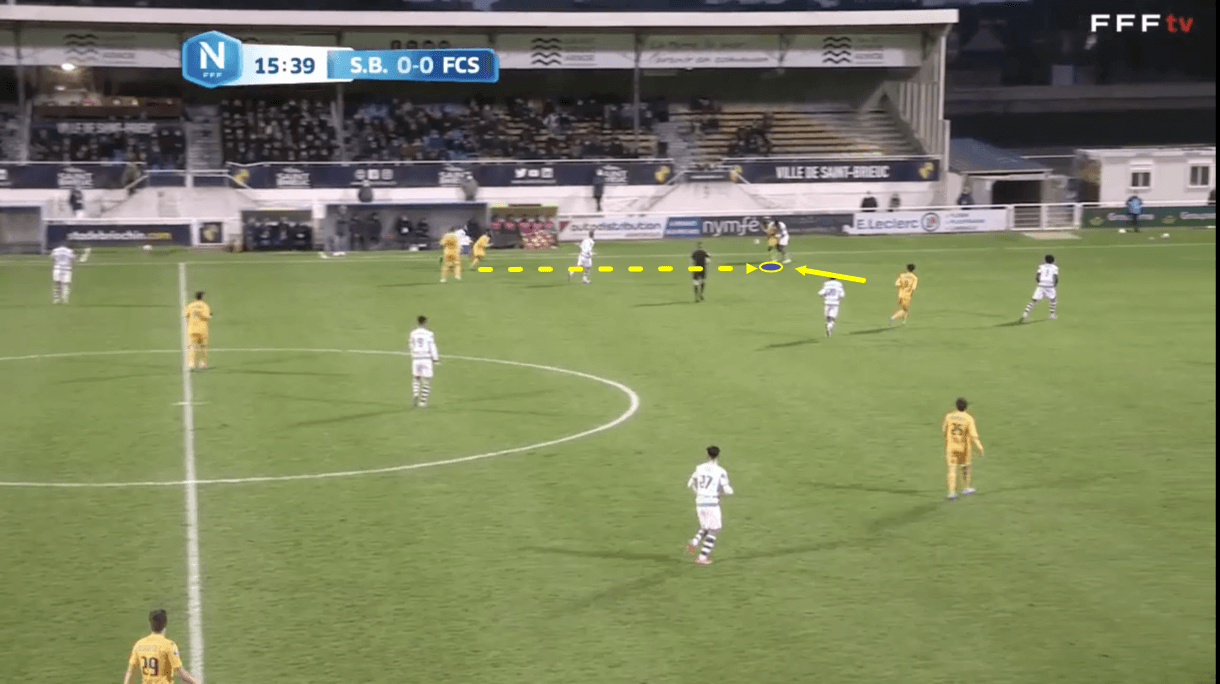
We see an example of Sagna’s ability to hold up the ball and how Stade Briochin have used it this season in figures 13-14. Firstly, just before figure 13, we saw Sagna move out further onto the left wing from a slightly more central position. As he moved out, presumably in an attempt to find more space, he was tracked by a defender who prevented the attacker from turning as he received a pass driven down the wing. So, Sagna was forced to play with his back to goal.
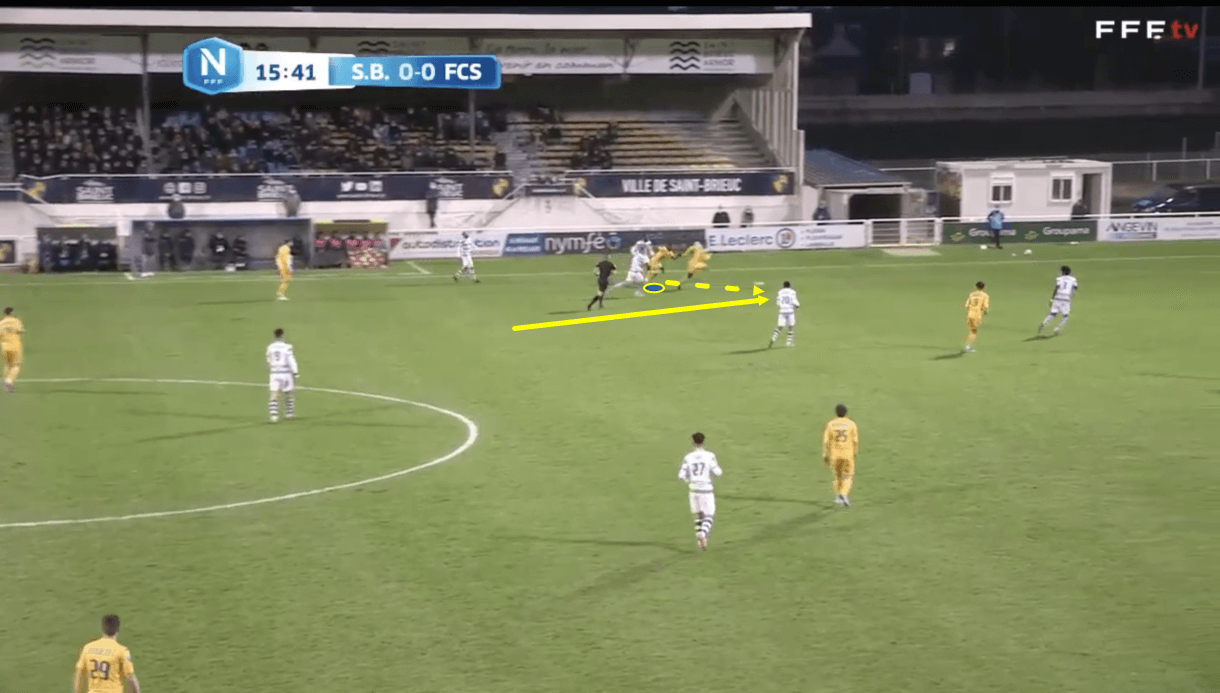
While the defender stopped Sagna from turning, he didn’t succeed in dispossessing the forward. Sagna was comfortable backing into the defender and holding up the ball while attracting more defenders towards him as he waited for the right moment to make his next move. In figure 14, we see that this next move came when a teammate got forward from deep and attacked the space next to Sagna, slightly more centrally, where the attacker had previously been standing before moving out onto the wing.
Sagna bided his time waiting for this teammate to get forward before swinging his hips around and playing the ball through to this runner on the inside, releasing him down the wing and driving Stade Briochin into the final third.
So, we can see from this short example how comfortable the 22-year-old generally is with receiving the ball to feet, holding up the play and linking up with teammates — firstly receiving the ball, then holding off the defender physically until he’s decided the right time has come to make his next move.
It must be said, Sagna shouldn’t be viewed as a guy who’s constantly making defence-splitting passes like this, as that’d be inaccurate. He can create via his hold-up play and wing play, however, which are major attributes in his game that should be taken advantage of. His strength combined with decent agility and a relatively low centre of gravity can help his team to gain significant ground, which is a big benefit in situations like we see in figures 13-14. His team has used him in this manner a lot throughout 2021/22.
Defensive actions
For our final section of analysis in this scout report, we’ll look at why his club labelled him their “defender on the front” in a recent tweet announcing him as one of their nominees for club player of the year. Sagna is not only active in carrying out his defensive duties, but a very effective asset in defensive phases. The attacker has made 5.19 successful defensive actions per 90 this term, which ranks fairly high when compared with other National 1 forwards. In particular, the 22-year-old loves to get stuck in with tackles and defensive duels.
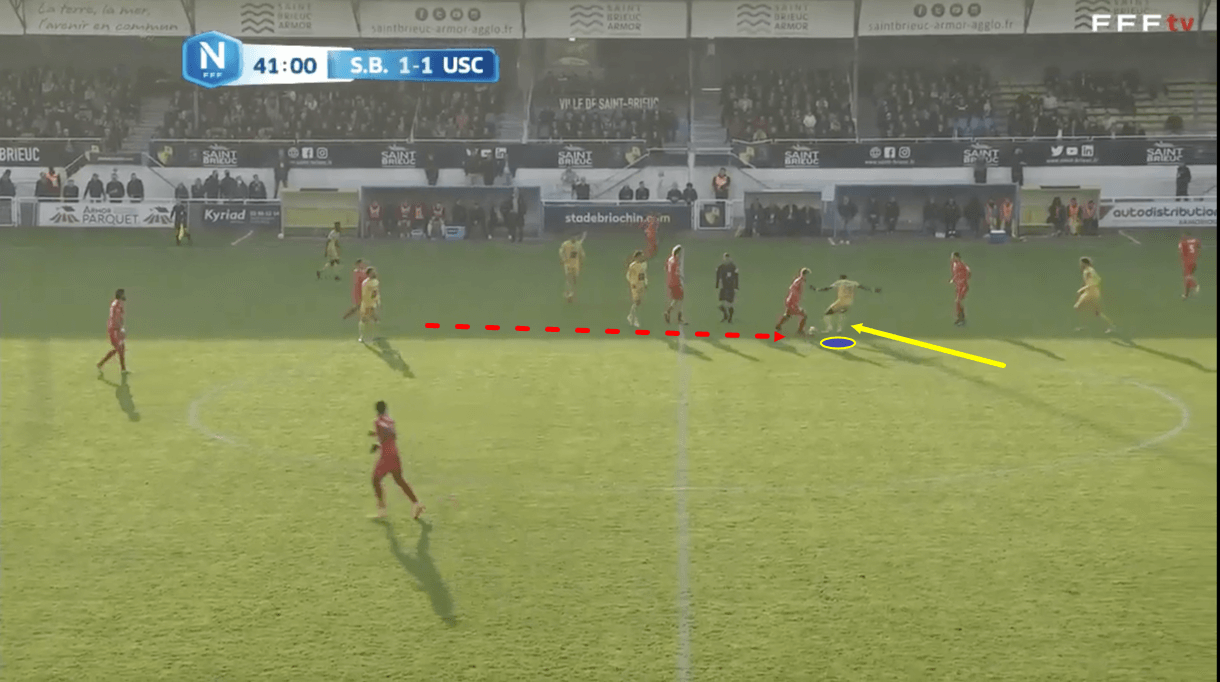
We see an example of the player’s impressive defensive work rate in figure 15. Just before this image, the opposition sent the ball backwards, leading to Sagna jumping out of his centre-forward position to chase a heavy touch taken by the opponent who the preceding pass was directed to, visible just inside the centre circle here. Sagna was quick and aggressive in entering the challenge. When he decided he’d go, he didn’t second-guess himself and fully went for it. This was important for the 50-50 challenge he ended up getting into with the opposition player in midfield.
As play moves on from figure 15, where we see Sagna entering into the challenge, the 22-year-old ends up coming out from the 50-50 on top, carrying the ball with him and regaining possession for Stade Briochin. The defensively-active forward was quick to capitalise on the opposition’s unforced error here, showcasing his awareness and reaction speed, as well as his technical defensive quality to come out of the challenge on top.
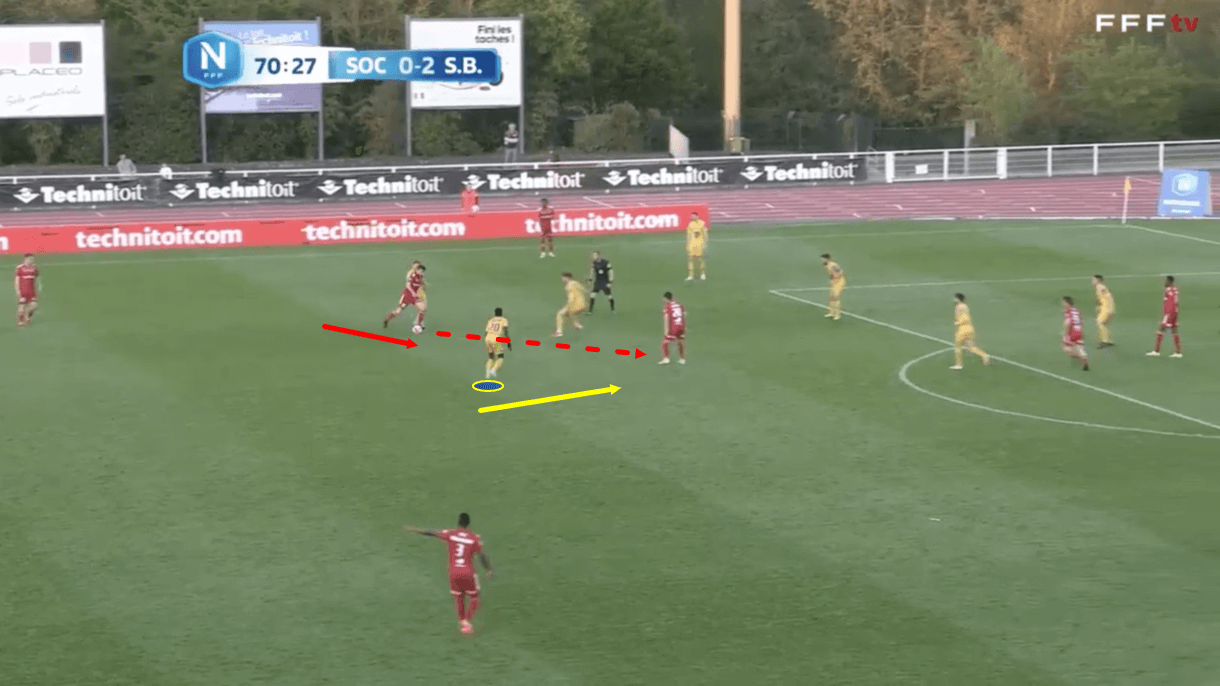
Lastly, in figures 16-17, we see an example of Sagna defending deeper. The forward is happy to track back and perform the defensive duties that his team requires from him, as this passage of play shows. This attitude and mentality have played a big part in the attacker being such a high-quality defensive asset for his side this term. In figure 16, we see the opposition trying to break into the final third, with a player on the edge of the final third enjoying plenty of space behind him to potentially turn into should he receive a pass from the teammate driving towards him here.
Sagna shows his defensive awareness again here as he intelligently positions himself in this space behind the attacker, the result of which we’ll see as we move on into figure 17.
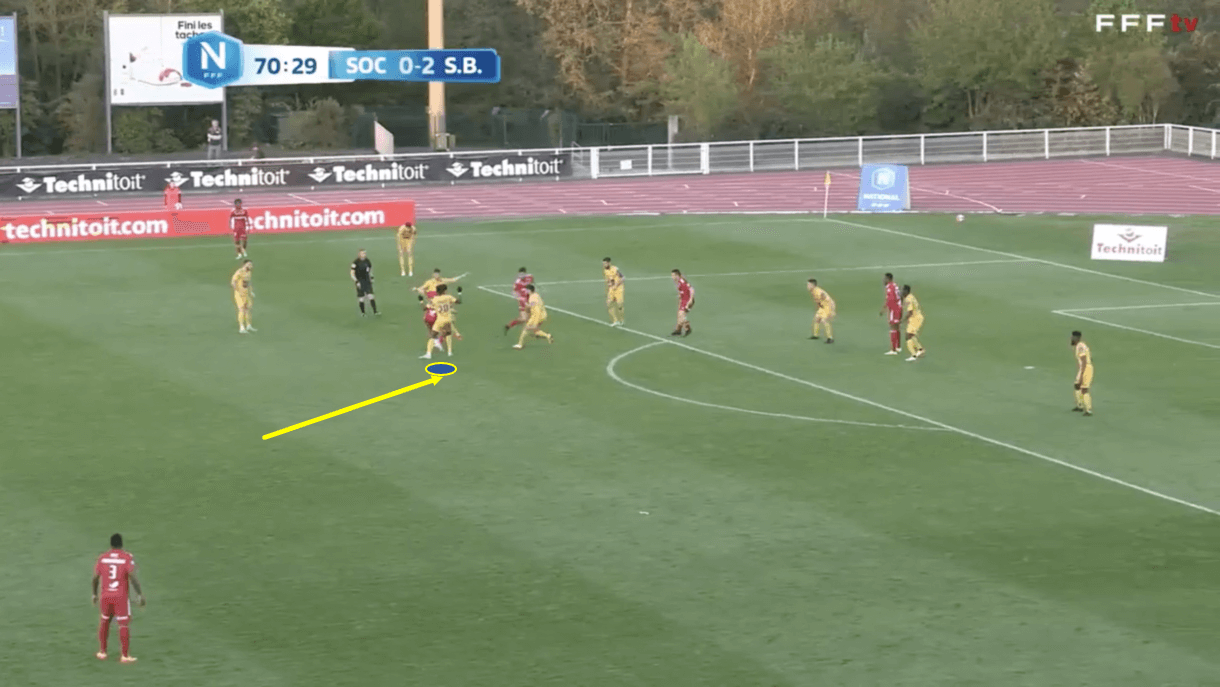
As figure 17 shows, the opposition receiver on the edge of the final third was prevented from turning into this space due to Sagna’s defensive movement. Instead, the player was forced to move backwards and into another Stade Briochin player. Needless to say, the attacker didn’t get out of this situation and was ultimately dispossessed.
This attack could’ve gone much differently had Sagna not made the diligent decision to occupy that space behind the attacker and cut off their potential to turn into the space and drive straight at the backline. This level of defensive effort and awareness should be commended, as it’s been a great asset for Stade Briochin this term that’s really bolstered their shape out of possession and made Sagna a difficult player to leave out of the team.
Conclusion
In conclusion, Sagna has been one of the most impressive forwards in France’s third tier this season, for me. While his goalscoring hasn’t been good enough and he needs both more composure in front of the opposition net and better shot selection at times, the player has excellent off-the-ball movement and great physical traits, as well as decent technical dribbling quality, that help him to get into high-value shooting positions more often than his actual goalscoring record suggests — and if he’s getting into those positions routinely, I’d expect the scales to balance out a little bit more, though he does still need to improve his composure in front of goal and shot selection. Sagna’s not a typical ‘playmaker’ but can create from the wings and via his hold-up play.
Lastly, off the ball, as his club said themselves, he is their “defender on the front” and offers an excellent defensive effort from the forward line — a bonus for his team when defending high or deep, as our final section of analysis showed. In terms of level, I don’t think Sagna is necessarily ready to go back to Club Brugge and be a key squad member but maybe he could be tested at a slightly higher level again next term to continue his development. He has the potential to be a helpful squad player for a Ligue 2-level side, for instance.





Comments